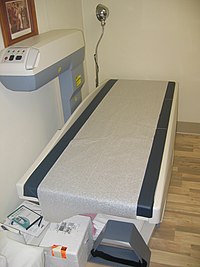
Photo from wikipedia
Abstract In premenopausal women, bone mineral density measurement by dual-energy X-ray absorptiometry should not be used as the sole guide for diagnosis or treatment of osteoporosis, universal screening with bone… Click to show full abstract
Abstract In premenopausal women, bone mineral density measurement by dual-energy X-ray absorptiometry should not be used as the sole guide for diagnosis or treatment of osteoporosis, universal screening with bone mineral density is not advised and the World Health Organization classification of bone status should not be applied. A diagnosis of premenopausal osteoporosis is reserved for those with evidence of fragility and may also be considered in women with low bone mass and an ongoing secondary cause of osteoporosis. Idiopathic osteoporosis in young women is rare. A thorough evaluation of secondary causes is indicated in all patients, with glucocorticoid treatment a common secondary cause of low bone mass and osteoporosis. Hypoestrogenism may be the primary cause of low bone mass and contribute to excessive bone loss in many conditions associated with premenopausal osteoporosis, and should be treated unless contra-indicated. The mainstay of treatment in premenopausal females with low bone mass includes risk factor reduction, advocating a healthy, active lifestyle and optimal treatment of secondary causes of bone loss. The safety of bone-specific therapy, especially long term and during pregnancy, remains uncertain. Bisphosphonates, teriparatide, denosumab and estrogen treatment increase bone density in premenopausal women with osteoporosis, but there are no study data confirming short-term fracture prevention with use of these agents.
Journal Title: Climacteric
Year Published: 2021
Link to full text (if available)
Share on Social Media: Sign Up to like & get
recommendations!